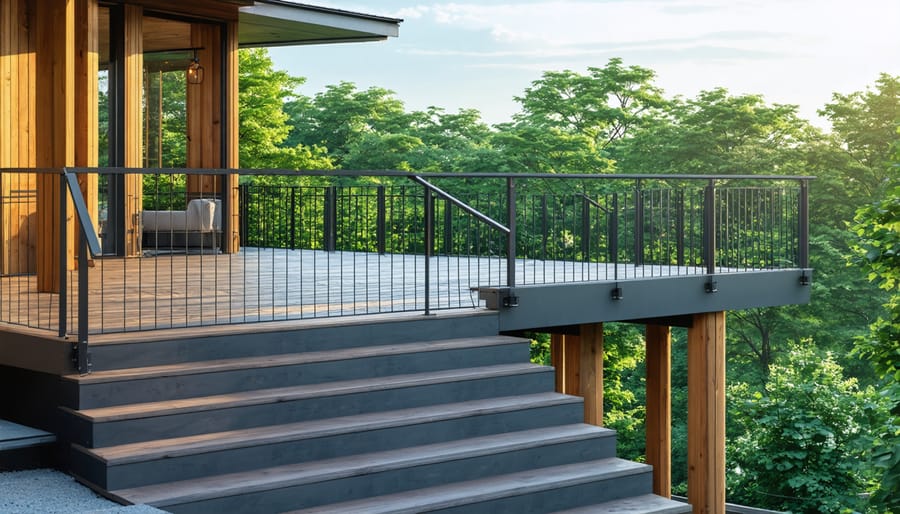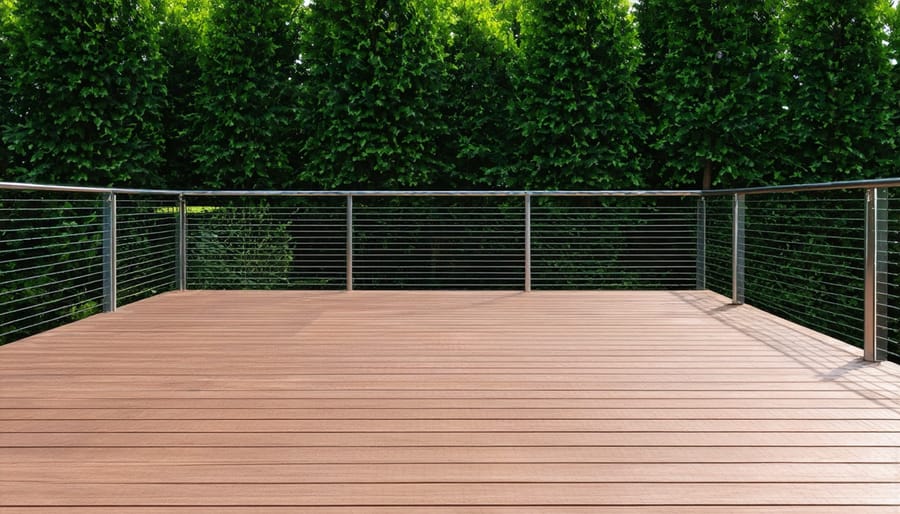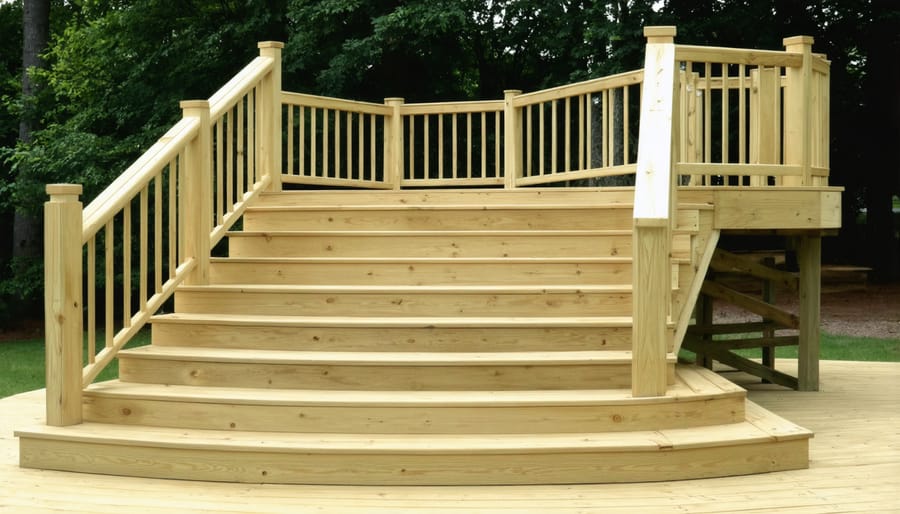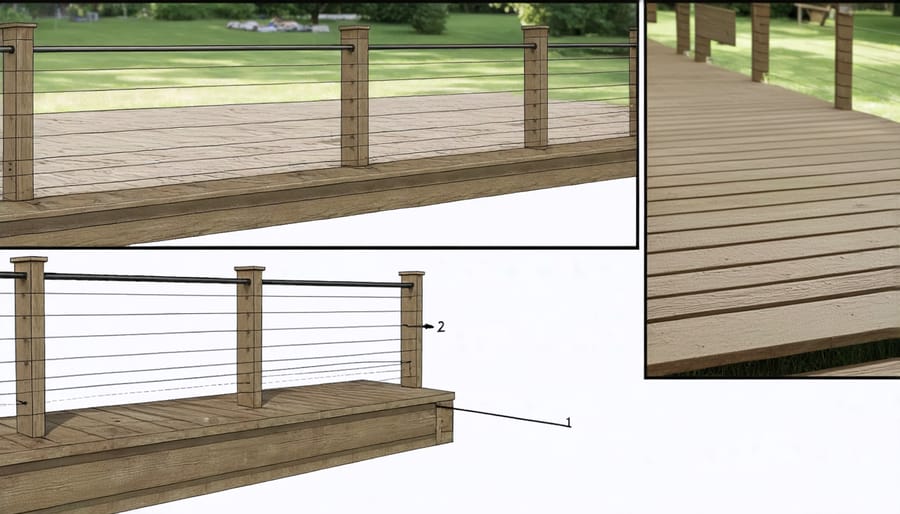
Beautiful Deck Stair Railings That Blend Safety With Style
Transform your deck’s safety and style with innovative stair railings ideas that blend functionality with modern design. From sleek cable railings that preserve your view to classic wrought iron balusters that add timeless elegance, deck stair railings serve as both crucial safety features and striking architectural elements.
Modern homeowners now choose from an impressive array of materials – weather-resistant composite, maintenance-free aluminum, richly textured wood, and industrial-chic metal combinations. Each option offers unique benefits, from the warm natural appeal of cedar to the contemporary clean lines of glass panels.
Beyond basic code compliance, today’s deck railings incorporate smart features like built-in LED lighting, hidden fastener systems, and modular components that simplify installation. Whether you’re planning a complete deck renovation or simply updating your existing railings, the right design choice can dramatically enhance your outdoor living space while ensuring family safety and boosting property value.
This comprehensive guide explores the latest trends, materials, and design possibilities to help you create the perfect deck stair railing that matches your home’s architecture and your personal style.
Modern Metal Deck Railing Designs
Cable Railing Systems
Cable railing systems offer a modern, sleek look that maximizes your view while maintaining safety standards. Available in both horizontal and vertical configurations, these systems use stainless steel cables stretched between posts to create an almost invisible barrier that’s both stylish and secure.
Horizontal cable systems are particularly popular for their contemporary appeal, typically using cables spaced 3-4 inches apart. Vertical cable arrangements, while less common, provide excellent safety for homes with children, as they eliminate the potential climbing hazard associated with horizontal installations.
When installing cable railings, proper tension is crucial. The cables must be tight enough to prevent sagging but not so tight that they stress the framework. Post spacing typically shouldn’t exceed 4 feet to maintain cable integrity and meet building codes. Consider using end posts with additional reinforcement to handle the cable tension.
Maintenance is relatively straightforward – occasional cleaning with mild soap and water keeps the cables looking pristine. Regular inspection of cable tension and hardware is recommended, with adjustments made as needed. While the initial cost may be higher than traditional options, the durability and minimal upkeep make cable systems a smart long-term investment.

Glass Panel Railings
Glass panel railings offer a modern, sophisticated look while maintaining unobstructed views of your surroundings. Available in both frameless and framed options, these railings create an elegant, floating appearance that works particularly well with contemporary home designs.
Frameless systems provide the cleanest look but typically cost more and require professional installation. Framed options offer additional support and easier DIY installation while still maintaining excellent visibility. Both styles are manufactured using tempered safety glass, ensuring durability and compliance with building codes.
The main advantages include weather resistance, minimal maintenance, and enhanced property value. However, glass panels do require regular cleaning to maintain their pristine appearance. Use a non-abrasive glass cleaner and soft cloth to remove fingerprints and water spots. Keep in mind that while beautiful, glass railings can be more expensive than traditional options and may show smudges more readily.
For coastal homes or properties with scenic views, glass panels are an excellent investment that combines safety with style.
Aluminum Balusters
Aluminum balusters offer a perfect blend of modern aesthetics and durability for deck stair railings. Available in various styles from simple round spindles to decorative square designs, these lightweight components come pre-finished in classic colors like black, bronze, and white. Some manufacturers even offer textured finishes that mimic wrought iron for a more traditional look.
Installation is straightforward with pre-drilled holes and universal connectors, making them a favorite among DIY enthusiasts. Most systems include top and bottom rails that secure the balusters in place, while specialty brackets ensure proper spacing and alignment. You can mix and match different baluster styles within the same section for unique visual interest.
For coastal homes, aluminum’s corrosion resistance makes it particularly appealing. These balusters require minimal maintenance beyond occasional cleaning, and their powder-coated finish prevents fading and rust. Many homeowners appreciate that aluminum systems come with pre-assembled sections, significantly reducing installation time while ensuring consistent spacing and professional results.
Traditional Wood Railing Designs
Classic Wooden Balusters
Classic wooden balusters remain a timeless choice for deck stair railings, offering warmth and traditional charm that complements virtually any home style. These vertical spindles typically feature elegant turned designs, from simple colonial styles to more ornate Victorian patterns, creating a sophisticated yet welcoming appearance.
Popular wood species for balusters include pressure-treated pine, cedar, and oak. Pine offers affordability and excellent weather resistance when properly treated, while cedar naturally resists decay and insects. Oak provides superior durability and a distinguished grain pattern, though it comes at a higher price point.
When selecting wooden balusters, consider both square and turned options. Square balusters offer a clean, contemporary look that’s easier to install, while turned designs provide that quintessential traditional appeal. Standard spacing between balusters should be no more than 4 inches to meet safety codes while maintaining visual appeal.
Finishing options are virtually limitless with wooden balusters. Clear sealants showcase the natural wood grain, while solid stains provide color while still allowing some wood texture to show through. Paint offers complete coverage and the opportunity to match or contrast with your home’s exterior colors. Whatever finish you choose, plan to maintain it every 2-3 years to ensure lasting beauty and protection.
For added character, consider mixing different baluster designs or incorporating decorative caps and post tops. These small details can transform a basic railing into an eye-catching architectural feature.
Craftsman-Style Railings
Craftsman-style railings embody the timeless principles of the Arts and Crafts movement, combining functionality with stunning artisanal details that can transform your deck stairs into an architectural focal point. These railings typically feature robust square balusters, distinctive post caps, and decorative geometric patterns that complement modern vintage design elements while maintaining their classic appeal.
The signature elements include thick, tapered columns supporting substantial handrails, often incorporating built-in lighting for both safety and ambiance. Traditional craftsman designs showcase mortise-and-tenon joinery, creating clean lines and sturdy connections that stand the test of time. Consider incorporating repeating square patterns, decorative cutouts, or lattice work between balusters to add visual interest while maintaining the style’s characteristic simplicity.
For an authentic craftsman look, opt for natural wood species like quarter-sawn oak, cedar, or mahogany. These materials develop a beautiful patina over time and can be stained in rich, earthy tones that highlight their natural grain patterns. To enhance durability while preserving the traditional aesthetic, many homeowners choose to combine wood with powder-coated metal accents in deep bronze or black finishes.
When planning your craftsman railing design, remember to balance ornamental details with practical functionality. Keep the overall structure sturdy and proportional to your home’s architecture while incorporating thoughtful details that make the railing uniquely yours.

Mixed Material Combinations
Wood and Metal Fusion
The fusion of wood and metal in deck stair railings creates a stunning visual impact through bold contrasting materials while offering exceptional durability. This combination perfectly balances warmth and industrial edge, making it a top choice for modern homes. Wooden posts provide a traditional foundation and can be stained to match your deck, while sleek metal balusters or cables add a contemporary twist.
Popular combinations include cedar or pressure-treated pine posts paired with black aluminum balusters or stainless steel cables. The metal components require minimal maintenance and won’t obstruct your view like traditional wooden spindles. For a more dramatic look, consider dark-stained wooden posts with brushed nickel or copper balusters.
Installation is straightforward with pre-drilled posts and ready-to-install metal components. Many manufacturers offer complete kits that include everything you need, from mounting brackets to end caps. The key to success lies in proper post spacing and ensuring all metal components are properly sealed where they meet the wood to prevent moisture damage.
This style works particularly well for homes that already feature mixed materials in their architecture, creating a cohesive look that connects indoor and outdoor spaces seamlessly.
Glass and Metal Integration
For a sophisticated and contemporary look, combining glass panels with metal frames creates a stunning visual statement on your deck stairs. This elegant pairing offers unobstructed views while maintaining safety and adding a touch of modern luxury to your outdoor space. Clear tempered glass panels, secured within sleek aluminum or stainless steel frames, provide a nearly invisible barrier that allows natural light to flow freely.
The metal components can be customized to match your home’s exterior, with popular finishes including brushed nickel, matte black, and oil-rubbed bronze. Consider mixing frosted or tinted glass panels with polished metal accents for added privacy and style. The frames can feature clean, straight lines for a minimalist look or incorporate decorative elements for more visual interest.
Installation typically involves mounting metal posts to your stairs, followed by securing pre-fabricated glass panels within metal channels or clips. While this option tends to be more expensive than traditional railings, it offers exceptional durability and requires minimal maintenance beyond regular cleaning. For coastal homes, marine-grade metals are recommended to prevent corrosion, and specialized glass treatments can reduce fingerprints and water spots.
This modern combination works particularly well for elevated decks where preserving views is a priority, and it can significantly increase your property’s curb appeal.
DIY Installation Tips
Tools and Materials
Before starting your deck stair railing project, gather these essential tools and materials to ensure a smooth installation process:
Basic Tools:
– Power drill with various drill bits
– Circular saw or miter saw
– Level (both standard and laser)
– Tape measure
– Pencil and marking tools
– Post hole digger (if installing new posts)
– Socket wrench set
– Safety equipment (goggles, gloves, dust mask)
Hardware and Fasteners:
– Deck screws (corrosion-resistant)
– Lag bolts and washers
– Post mounting brackets
– Concrete anchors (if needed)
– Rail connectors and brackets
– Galvanized nails
Materials (depending on chosen design):
– Railing posts
– Top and bottom rails
– Balusters or spindles
– Post caps and decorative elements
– Concrete mix (for post installation)
– Weather-resistant wood sealant or paint
– Construction adhesive
Optional Tools:
– Router (for decorative edges)
– Stair gauge
– Post level
– Speed square
– Chalk line
Having these items ready before beginning will help avoid delays and ensure proper installation of your deck stair railing.

Installation Steps
Before starting your installation, gather all necessary stair rail parts and tools. Begin by measuring your staircase and marking post locations, ensuring they’re spaced according to local building codes (typically 4-6 feet apart).
Start by installing the bottom post, securing it firmly to the deck structure using lag bolts or through-bolts. Move to the top post, making sure it’s perfectly plumb using a level. Install any intermediate posts following the same process.
Measure and cut your handrails to length, allowing for proper angles at connections. Attach rail brackets to your posts at the correct height (usually 34-38 inches from the nose of the stair tread). Secure the handrail to the brackets, ensuring it’s level and stable.
For balusters, mark spacing equally (maximum 4 inches apart), install bottom rail supports, and secure balusters one at a time. Finally, add any decorative caps or post covers, and double-check all connections are tight and secure.
Remember to always check local building codes before starting your project, as requirements can vary by location.
Safety Considerations
Safety should always be your top priority when installing deck stair railings. Building codes typically require railings to be at least 36 inches high and able to withstand 200 pounds of force in any direction. Balusters must be spaced no more than 4 inches apart to prevent children from getting stuck or falling through. The handrail should be graspable, with a diameter between 1¼ and 2 inches, and extend the full length of the stairs.
For deck stairs more than 30 inches above ground level, additional safety measures are mandatory. Always check your local building codes, as requirements can vary by location. Ensure your railing posts are properly anchored to the deck structure and stairs, using appropriate hardware and waterproof sealants to prevent rust and deterioration. Regular inspections and maintenance will help keep your railings safe and sturdy for years to come.
Choosing the perfect deck stair railing is about finding that sweet spot between style, safety, and functionality. Throughout this guide, we’ve explored various designs and materials that can transform your deck stairs from a simple necessity into a stunning architectural feature. Whether you’re drawn to the timeless appeal of traditional wooden railings, the modern sleekness of metal and glass, or the low-maintenance benefits of composite materials, there’s a perfect solution for every home.
Remember that while aesthetics are important, safety should always be your top priority. Ensure your chosen design meets local building codes and provides sturdy support for everyone using your stairs. Consider factors like weather resistance, maintenance requirements, and durability when making your final decision.
Your deck railing doesn’t just serve as a safety feature – it’s an opportunity to enhance your home’s curb appeal and outdoor living space. Take time to evaluate how different styles complement your home’s architecture and existing outdoor elements. Don’t be afraid to mix materials or incorporate unique elements like built-in lighting or decorative balusters to create a truly personalized design.
Whatever style you choose, proper installation is crucial for both safety and longevity. If you’re not confident in your DIY skills, working with a professional contractor can ensure your railing meets all requirements and stands the test of time.
With the right design and materials, your deck stair railing can be both a practical safety feature and a beautiful addition to your outdoor space. Take inspiration from the ideas we’ve shared and create a railing that perfectly suits your home’s style while keeping your family and guests safe for years to come.
